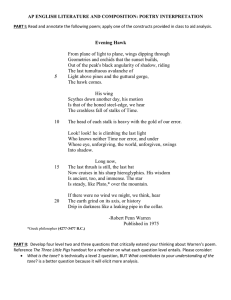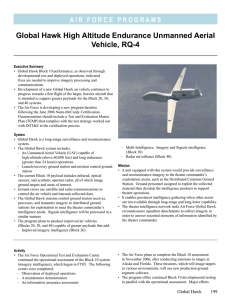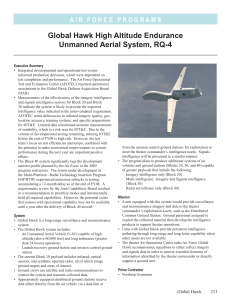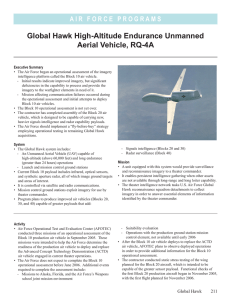Global Hawk High Altitude Endurance Unmanned Aerial Vehicle, RQ-4
advertisement
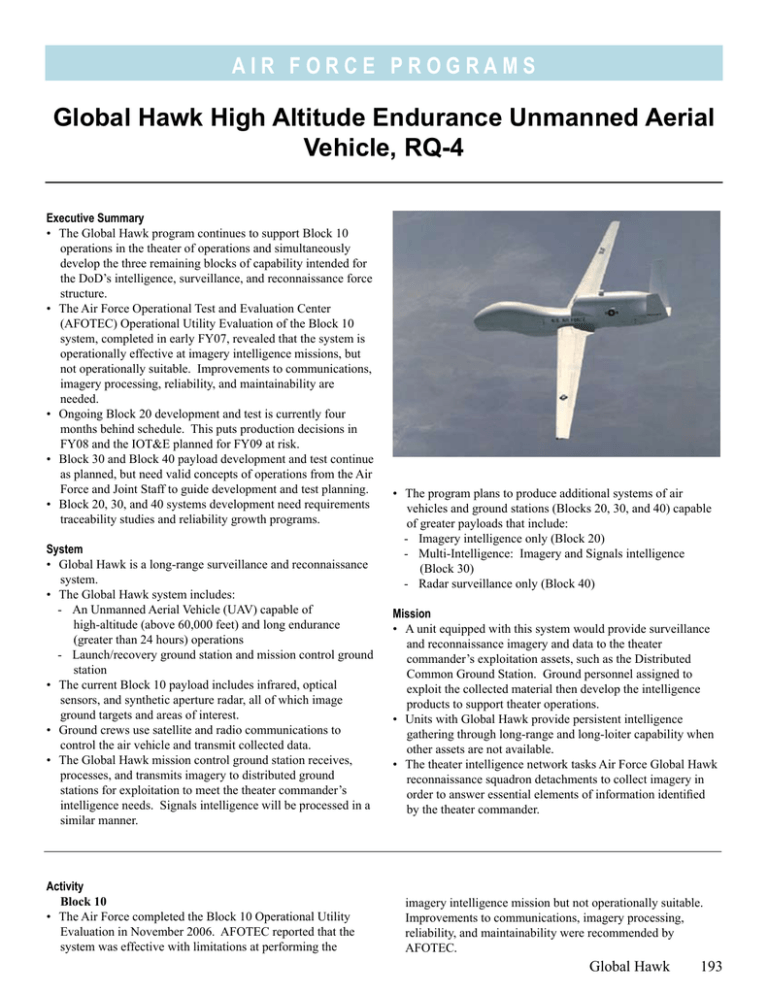
A i r F o r c e P RO G R A M S Global Hawk High Altitude Endurance Unmanned Aerial Vehicle, RQ-4 Executive Summary • The Global Hawk program continues to support Block 10 operations in the theater of operations and simultaneously develop the three remaining blocks of capability intended for the DoD’s intelligence, surveillance, and reconnaissance force structure. • The Air Force Operational Test and Evaluation Center (AFOTEC) Operational Utility Evaluation of the Block 10 system, completed in early FY07, revealed that the system is operationally effective at imagery intelligence missions, but not operationally suitable. Improvements to communications, imagery processing, reliability, and maintainability are needed. • Ongoing Block 20 development and test is currently four months behind schedule. This puts production decisions in FY08 and the IOT&E planned for FY09 at risk. • Block 30 and Block 40 payload development and test continue as planned, but need valid concepts of operations from the Air Force and Joint Staff to guide development and test planning. • Block 20, 30, and 40 systems development need requirements traceability studies and reliability growth programs. System • Global Hawk is a long-range surveillance and reconnaissance system. • The Global Hawk system includes: - An Unmanned Aerial Vehicle (UAV) capable of high‑altitude (above 60,000 feet) and long endurance (greater than 24 hours) operations - Launch/recovery ground station and mission control ground station • The current Block 10 payload includes infrared, optical sensors, and synthetic aperture radar, all of which image ground targets and areas of interest. • Ground crews use satellite and radio communications to control the air vehicle and transmit collected data. • The Global Hawk mission control ground station receives, processes, and transmits imagery to distributed ground stations for exploitation to meet the theater commander’s intelligence needs. Signals intelligence will be processed in a similar manner. Activity Block 10 • The Air Force completed the Block 10 Operational Utility Evaluation in November 2006. AFOTEC reported that the system was effective with limitations at performing the • The program plans to produce additional systems of air vehicles and ground stations (Blocks 20, 30, and 40) capable of greater payloads that include: - Imagery intelligence only (Block 20) - Multi-Intelligence: Imagery and Signals intelligence (Block 30) - Radar surveillance only (Block 40) Mission • A unit equipped with this system would provide surveillance and reconnaissance imagery and data to the theater commander’s exploitation assets, such as the Distributed Common Ground Station. Ground personnel assigned to exploit the collected material then develop the intelligence products to support theater operations. • Units with Global Hawk provide persistent intelligence gathering through long-range and long-loiter capability when other assets are not available. • The theater intelligence network tasks Air Force Global Hawk reconnaissance squadron detachments to collect imagery in order to answer essential elements of information identified by the theater commander. imagery intelligence mission but not operationally suitable. Improvements to communications, imagery processing, reliability, and maintainability were recommended by AFOTEC. Global Hawk 193 A i r F o r c e P RO G R A M S • Follow-on testing, including the verification of corrections to communications and navigation deficiencies, continued at Beale AFB and Edwards AFB, California. • The Maritime Demonstration being conducted at Patuxet River Naval Air Station, Maryland, is providing proof of concept data and performance data for use of a maritime sensor on Global Hawk. • Global Hawk flight operations (pilot training and test missions) at the Main Operating Base located at Beale AFB, California, continued, although at a slower pace than planned. The Air Force continues to work with Federal Aviation Administration (FAA) officials to resolve issues to allow normalized flight operations. Block 20 • Block 20 development and test are four months behind schedule. The program conducted two Block 20 test flights in the seven months since the first flight on March 1, 2007. - A landing gear door separated from the aircraft on the first flight, requiring a change in configuration. The second developmental test flight was consequently delayed until July 24, 2007. - The most recent mission took place on October 18, 2007, but returned early due to flight control surface anomalies. - An engine inlet distortion anomaly, requiring additional engineering analysis, was also discovered. • An Operational Assessment, planned for September to October 2007, designed by AFOTEC to measure progress towards readiness for the IOT&E in 2009, has been delayed until early FY08. Block 30 • The first Global Hawk Block 30 air vehicle test flight is planned for January 2008. • Development and initial testing of the Airborne Signals Intelligence Payload (ASIP), which is intended to provide the Block 30 multi-intelligence capability, continues on the U-2 aircraft. AFOTEC designed an Operational Assessment on the U-2 to measure progress towards readiness for the Global Hawk Block 30 IOT&E in 2009. This early involvement activity will provide a performance assessment for a December 2007 low-rate production decision on the ASIP payload. Block 40 • The first Global Hawk Block 40 air vehicle test flight is planned for June 2010. • Initial testing of the Radar Technology Improvement Payload (RTIP), which is the sole intended payload for the Block 40, is being conducted on a surrogate unmanned air vehicle, Proteus. Proteus integration is similar to that intended for Global Hawk. Assessment Block 10 • The Air Force continued to mature the Block 10 system. DOT&E concurred with the findings of the AFOTEC report on the Block 10 Operational Assessment. Increased combat operational tempo combined with less-than-predicted reliability and limited spares of key components resulted in 194 Global Hawk a declining Block 10 mission capable rate. Remedial actions under investigation by the program now may improve Block 10 reliability. • The limited number, duration, and frequency of flight authorizations from the FAA had an adverse impact on the Air Force’s ability to conduct Global Hawk operations (pilot training and test missions) and mature the program as planned at the Main Operating Base located at Beale AFB, California. Low Global Hawk system reliability adversely affects the ability to consistently fly on a limited schedule. Block 20 • Block 20 air vehicle performance cannot be determined from flight test conducted thus far. The pace of flight test needs to increase in order to gain confidence in the new, larger aircraft design, propulsion system, and sensor operations. • The program needs to recover approximately four months of schedule lag in the next six to nine months in order to reduce the risk that IOT&E for Block 20 will be delayed. The initiation of a new Combined Test Force organization at Edwards AFB, California, increases the likelihood that reasonable schedules and accurate performance assessments from developmental testing will be available in the future. • It is high risk that the AFOTEC Operational Assessment will be available for the June 2008 production decision for Lot 7, which would be a breach of the integrated test strategy put in place through the 2006 Nunn-McCurdy certification. • Block 20 development does not currently include a reliability growth program. Block 30 • Initial testing of the signals intelligence payload has progressed with minor delays. More comprehensive, integrated developmental testing, and an early FY08 AFOTEC Operational Assessment will yield a more complete understanding of the multi-intelligence capability planned for Global Hawk. • Planning for the Block 30 IOT&E is hampered by the lack of a validated concept of operations for the multi-intelligence Block 30 capability. Among other issues, the concept of operations needs to address consolidating or separating exploitation of imagery and signals processing. This could affect how the system is tasked and operated. To be adequate, the operational test must provide an appropriate operational environment using the concept of operations. • Block 30 development does not currently include a reliability growth program. Block 40 • Initial developmental test results for the RTIP payload are being sent to DOT&E for analysis. The test team has maintained the planned schedule thus far. • The RTIP program documentation (test and evaluation master plan, acquisition strategy, acquisition program baseline) requires updates to reflect changes in the program since the cancellation of the E-10 platform. A i r F o r c e P RO G R A M S • As part of the updates, the Air Force test strategy needs an Operational Assessment of the RTIP payload capability, conducted by AFOTEC during the planned verification events, before production decisions in FY09. • As with the Block 30 system, the Block 40 system lacks a validated concept of operations. The lack of this important piece means development and test planning proceed without benefiting from how the Service will integrate the Global Hawk system capability in the intended joint environment. • Block 40 development does not currently include a reliability growth program. Recommendations • Status of Previous Recommendations. The Air Force completed the Block 10 Operational Utility Evaluation and committed to conduct a Block 20/30 IOT&E (including a multi-intelligence Block 30 system) and a Block 40 IOT&E prior to making separate full-rate production decisions on these systems. The following three previous recommendations remain valid. - Contrary to DOT&E’s recommendation to conduct a review and correct deficiencies in the intelligence, surveillance, and reconnaissance network in which Global Hawk operates, no comprehensive review has taken place, nor is one known to be planned by the Air Force. This recommendation could be largely answered by producing a valid concept of operations for the Block 30 and Block 40 systems (FY05). - In response to DOT&E’s recommendation that low-rate initial production quantities should not be increased until after an adequate IOT&E of the Block 20 and Block 30 systems, the proposed acquisition strategy authorizes three additional lots of systems but reduces annual quantities of air vehicles to five per year until FY09. However, as recommended below, due to the delay in the Block 20 Operational Assessment, the DoD should place additional limits to production of air vehicles and/or sensor payloads in FY08 until the independent operational assessment is available for the defense acquisition executive (FY05). - The Air Force has not established a central government‑managed archive of Global Hawk test and operational performance data and reports (FY06). • FY07 Recommendations. The program should: 1. Limit production quantities of air vehicles and/or payloads planned for FY08 until the Block 20 Operational Assessment is complete and this independent report on performance and progress towards the Block 20/30 IOT&E is available. 2. Complete and validate the concepts of operations for initial deployment of Block 30 and Block 40 systems by the end of FY08. 3. Consolidate test and evaluation planning for Global Hawk, ASIP, and RTIP to ensure there are no resource gaps for operational testing. For this purpose, develop a test planning working group that includes the developmental test and operational test directors for each Global Hawk block and all payloads programs. 4. Demonstrate the degree to which requirements in the validated Global Hawk CDD are traceable to the performance that the actual design of the Block 20, 30, and 40 systems are predicted to yield. 5. Develop and implement a reliability growth program for each Global Hawk block system. 6. Re-engage with the FAA on unmanned air vehicle operations in continental operations - define and meet specific requirements for normalizing flying operations. 7. Conduct an operational assessment of the RTIP payload before the FY09 production decision. Global Hawk 195 A i r F o r c e P RO G R A M S 196
